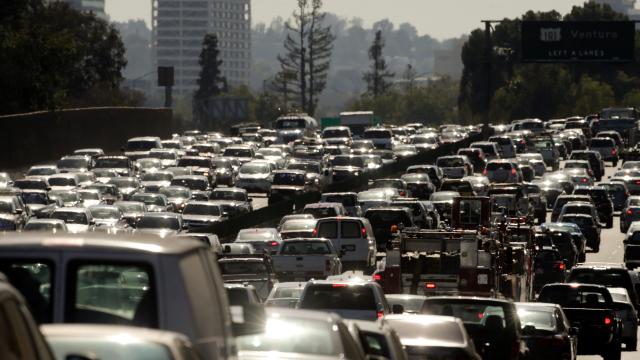Cars are as wrapped up in Los Angeles’ identity as tacos, the Hollywood sign, and palm trees. But the auto culture could change dramatically in the next few decades. On Monday, the city introduced its version of a Green New Deal and while it won’t quite ban cars, it will alter transit in the city.
The Los Angeles version of the Green New Deal would ban carbon spewing cars by 2050, reduce vehicle miles travelled, looking at congestion pricing, and build out public transit, walking and biking options, and electric vehicle charging infrastructure. It also focuses on building more housing near transit in an effort to ease the structural inequalities of Los Angeles. But while the end goals of decarbonisation are in line with science, the actual steps to get there might be not be strong enough to meet them.
“Our generational battle against climate change is a moral imperative, an environmental emergency, and an economic opportunity,” Los Angeles Mayor Eric Garcetti said in a letter announcing the Green New Deal for his city.
To address the climate emergency, Los Angeles will have to think about what its roads look like. The cars that prowl the county’s nearly 35,406km of free way, streets, and alleys are a big part of Los Angeles’ carbon footprint. Overall, transportation is responsible for 21 per cent of the city’s carbon emissions. While the city’s Green New Deal will tackle every source of greenhouse emissions, and while buildings and industry emit more, nothing has the potential to affect daily life more for Angelenos than reining in the emissions coming from tailpipes.
One of the centrepieces of the city’s plan is to increase the number of zero emissions vehicles to 25 per cent by 2025, leaping to 80 per cent by 2035, and reaching 100 per cent by 2050. That effectively means banning the combustion engine, something other cities and countries have plans to do as well, though on a more aggressive timeline.
Mandating that alone won’t make it so, though, and the city has some steps to get there. For example, it will add 28,000 electric vehicle charging stations, in addition to ramping up electric vehicle sharing programs in low income neighbourhoods.
The city also plans to help ensure Angelenos drive less by increasing access to public transit and making it easier to bike, walk or hop on a shared scooter. By 2025, the city wants citizens’ to take 35 per cent of all trips via one of those means, ramping up to 50 per cent by 2035. That means building out infrastructure, including 28 public transit projects, and ensuring that 75 per cent of new housing built by 2035 is within 457.20m of transit.
There’s even a commitment to study congestion pricing similar to New York’s recently passed policy, and a fossil fuel-free transit zone.
According to the report, reducing people’s dependence on cars by just 15 minutes per day will result in 788,000 new jobs, reduce vehicle miles travelled by 5 million miles per day, and cut the risk of heart disease and stroke by 23 per cent. But even with these benefits and despite how ambitious it sounds, this version of the Green New Deal may not prove tenable or nearly enough.
“While the LA GND document sets some good targets for reducing vehicle mileage, the action steps are far too timid and vague to make good on them,” Ben Fried, a spokesperson for the nonprofit Transit Center, told Earther in an email.
As the plan notes, the city has implemented some of the most aggressive subway and light rail expansion projects in the U.S. But during that same time, LA has seen ridership decline on its bus and rail lines. The Green New Deal includes calls for “cool corridors” to improve access to bus stops and new bike lanes in places like Watts, but Fried said that’s a stop gap at best that won’t fix the structural issues.
“Los Angeles has hardly any bus lanes, walking to transit stops is uncomfortable at best and often outright dangerous, and even new development by transit stations tends to include huge parking garages that encourage driving and dampen transit use,” Fried said.
“What’s missing from the plan are ambitious, specific targets to build out a network of bus lanes, redesign streets for pedestrian safety, and eliminate parking requirements. These policies would go a long way toward increasing walking and transit trips relative to driving, without breaking the bank.”
Teasing out those solutions in more detail reflects the hard work Los Angeles will need to do. Angelenos collectively drive 60 million miles every day according to the new plan, enough mileage to get to the moon and back 125 times.
Other American cities are similarly car-centric and will have to work to find similar solutions. Or, they could just be more like New York.
